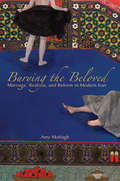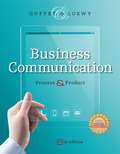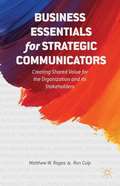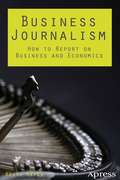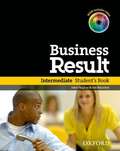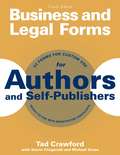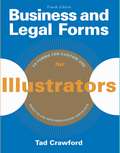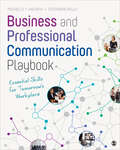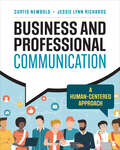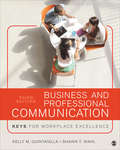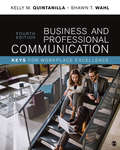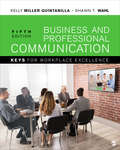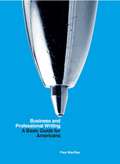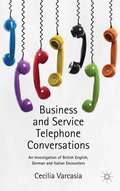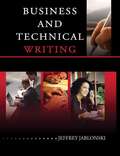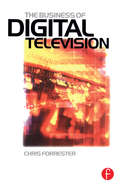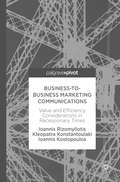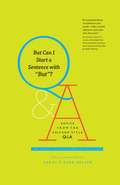- Table View
- List View
Burying the Beloved
by Amy MotlaghBurying the Beloved traces the relationship between the law and literature in Iran to reveal the profound ambiguities at the heart of Iranian ideas of modernity regarding women's rights and social status. The book reveals how novels mediate legal reforms and examines how authors have used realism to challenge and re-imagine notions of "the real." It examines seminal works that foreground acute anxieties about female subjectivity in an Iran negotiating its modernity from the Constitutional Revolution of 1905 up to and beyond the Islamic Revolution of 1979. By focusing on marriage as the central metaphor through which both law and fiction read gender, Motlagh critically engages and highlights the difficulties that arise as gender norms and laws change over time. She examines the recurrent foregrounding of marriage at five critical periods of legal reform, documenting how texts were understood both at first publication and as their importance changed over time.
Business Communication: Process & Product
by Mary Ellen Guffey Dana LoewyA trusted market leader, BUSINESS COMMUNICATION: PROCESS AND PRODUCT presents the market's most innovative coverage of workplace communication skills with an expanded emphasis on digital writing.
Business Essentials for Strategic Communicators
by Matthew W. Ragas Ron CulpThe rise of digital media and the public's demand for transparency has elevated the importance of communication for every business. To have a voice or seat at the table and maximize their full value, a strategic communicator must be able to speak the language and understand business goals, issues, and trends. The challenge is that many communicators don't hold an MBA and didn't study business in college. Business Essentials for Strategic Communicators provides communication professionals and students with the essential "Business 101" knowledge they need to navigate the business world with the best of them. Readers will learn the essentials of financial statements and terminology, the stock market, public companies, and more all with an eye on how this knowledge helps them do their jobs better as communication professionals. "
Business Journalism: How to Report on Business and Economics
by Keith HayesBusiness Journalism: How to Report on Business and Economics is a basic guide for journalists working in countries moving to open-market economies, students in journalism courses, journalists changing direction from general news reporting to business and economic reporting, and bloggers. It also explains the differences in technique required for general reporters to deliver business news for text, TV, or radio. Veteran journalist Keith Hayes, who has worked for such organizations as Reuters, PBS, the BBC, CBC, and CNBC, provides a quick reference to journalistic practice that covers everything from how to meet a deadline to getting answers from company or government officials who would rather not talk. It also provides background on specific knowledge that journalists should have to report on the business and the economy accurately and with insight. That includes understanding the major markets and how they work, learning to read a balance sheet, and getting the story even when a company or government sets up roadblocks. As Hayes demonstrates, effective journalists are story tellers who need to tell the story well while making certain they are providing the facts as they find them and understand them. Among other things, readers will also learn: How to write a business news story How to report business news on television How to report in a globalized business world How to get usable information from press conferences and briefings The basics of macroeconomics, the financial markets, and company-specific financial data How to dig for facts and get the story This book covers comprehensively the basics of business and economic reporting. With its insights and tips from Hayes and other veteran journalists, it's a book that will remain on your shelf for years to come and help you acquire and cement career-enhancing skills. It will also help you hone your craft as you begin to write more sophisticated stories and take jobs of increasing responsibility. What you'll learn Good basic journalistic practice How to write an effective business news article Reporting business for television Basics of economic reporting and the importance of the census Understanding financial markets and privatization Reading and interpreting company accounts Who this book is for Journalism students; novice journalists; experienced journalists in general news who want to switch to business reporting; and journalists in emerging economies where training opportunities are sparse. Table of Contents Establishing Good Journalistic Practices Writing an Effective Business News Article Writing for the Different Business News Media Establishing Sources of Information Enterprise Reporting Ethics and Change Making Economic Reporting Relevant Getting the Best from Press Conferences and Briefings Television Reporting Skills Reporting on Business for Television Newswires and their Role Getting the Pictures Writing and Reporting for New Media Macroeconomics Globalization and Comparisons with Neighboring Economies Stock and Bond Markets Markets for Commodities and Exotic Financial Products Investigating Company Accounts and Assessing the Board Privatization SMEs and the Economy The Importance of a Census Current Reporting: The Good, The Bad, and The Ugly The Pros Speak Sample Balance Sheet
Business Result Intermediate/Student Book
by John Hughes Jon NauntonBusiness Result is a five-level business English course that gives students the communication skills they need for immediate use at work. Business Result helps those who need to communicate better in English at work, by teaching a range of business communication skills. A list of outcomes in every unit shows students the language and skills they will learn.
Business and Legal Forms for Authors and Self-Publishers (Business and Legal Forms Series)
by Michael Gross Tad Crawford Stevie FitzgeraldProfessional and aspiring writers, including those who wish to self-publish, will find indispensable tools in this practical, complete, and time-saving popular resource. Business and Legal Forms for Authors and Self-Publishers contains all of the essential forms for success, including assignment confirmations, contracts between author and agent, publisher, collaborator, designer, printer, sales representative, book distributor, and more, copyright applications and transfers, licenses of rights (including electronic rights), permissions, nondisclosure, and invoices. The collection includes a CD-ROM with all the forms as well as a QR Code. In addition to updating the entire book, this fourth edition includes new material covering: Digital Millenial Copyright Act (DMCA) take down notices Dunning letters to go after royalties or fees owed Small claims court, arbitration, and mediation Statutory right of termination notice Self-publishing contracts, including what to avoid for both physical books and e-books Step-by-step instructions, advice on standard contractual provisions, and unique negotiation checklists are presented to aid in achieving the best results. Thorough discussions of contractual issues relevant to the industry make this a must-read for any author or self-publisher seeking the path to success.
Business and Legal Forms for Illustrators (Business And Legal Forms Ser.)
by Tad CrawfordThe fourth edition of this popular guide contains twenty-nine of the most essential business and legal forms to meet the everyday needs of today’s illustrators. Updated throughout, new forms include a promissory note, releases, and an agreement to arbitrate. Each form is accompanied by step-by-step instructions, advice on standard contractual provisions, and unique negotiation checklists for making the best deal. Included are:Estimate Confirmation of Assignment Invoice Illustrator-Agent Contract Book Publishing Contract Collaboration Contract Contract for the Sale of an Artwork Contract for Receipt and Holding of Artwork Illustrator-Gallery Contract with Record of Consignment and Statement of Account Licensing Contract to Merchandise Images Release Form for Models Property Release Permission Form Nondisclosure Agreement for Submitting Ideas Copyright Transfer Form Application for Copyright Registration of Artwork License of Rights and Electronic Rights Contract with an Independent Contractor Trademark Application Commercial Lease Sublease Lease AssignmentThe collection provides a password and link to a supplemental website, which contains all the discussed forms for both the PC and Mac platforms. Thorough discussions of legal issues relevant to the industry make this a must-read for any illustrator-established or starting out.Allworth Press, an imprint of Skyhorse Publishing, publishes a broad range of books on the visual and performing arts, with emphasis on the business of art. Our titles cover subjects such as graphic design, theater, branding, fine art, photography, interior design, writing, acting, film, how to start careers, business and legal forms, business practices, and more. While we don't aspire to publish a New York Times bestseller or a national bestseller, we are deeply committed to quality books that help creative professionals succeed and thrive. We often publish in areas overlooked by other publishers and welcome the author whose expertise can help our audience of readers.
Business and Professional Communication Playbook: Essential Skills for Tomorrow′s Workplace
by Michelle T. Violanti Stephanie E. KellyBusiness and Professional Communication Playbook teaches students the essentials of business communication and necessary skillset that employers look for today. Michelle Violanti and Stephanie Kelly use engaging examples, provide tips on how to carry yourself professionally, and incorporate real-life experiences from recent graduates to teach students how to communicate like a professional. Focused, bite-sized chapters on the most important topics in business communication, such as interviewing, writing resumes, and leading team presentations will motivate students to read and prepare ahead of time so instructors can focus on skill-building during class. By using this simple and flexible format, this text will provide students and instructors with an excellent foundation for a successful Business Communication course. This title is accompanied by a complete teaching and learning package in SAGE Vantage, an intuitive learning platform that instructors and students actually love.
Business and Professional Communication Playbook: Essential Skills for Tomorrow′s Workplace
by Michelle T. Violanti Stephanie E. KellyBusiness and Professional Communication Playbook teaches students the essentials of business communication and necessary skillset that employers look for today. Michelle Violanti and Stephanie Kelly use engaging examples, provide tips on how to carry yourself professionally, and incorporate real-life experiences from recent graduates to teach students how to communicate like a professional. Focused, bite-sized chapters on the most important topics in business communication, such as interviewing, writing resumes, and leading team presentations will motivate students to read and prepare ahead of time so instructors can focus on skill-building during class. By using this simple and flexible format, this text will provide students and instructors with an excellent foundation for a successful Business Communication course. This title is accompanied by a complete teaching and learning package in SAGE Vantage, an intuitive learning platform that instructors and students actually love.
Business and Professional Communication: A Human-Centered Approach
by Curtis Newbold Jessie Lynn RichardsBusiness and Professional Communication: A Human-Centered Approach prepares students to succeed in today’s workplace defined by changing technology, a diversifying workforce, and an increase in remote and hybrid work. Authors Curtis Newbold and Jessie Lynn Richards guide students through the principles, practices, and techniques, helping them see that business communication is more than just a series of documents, meetings, and presentations – it’s a human-centered process that requires a holistic understanding of communication across modes and contexts. With accessibility and inclusion leading the way, this text encourages students to be more conscientious, purposeful, and ethical in the way they communicate at work and beyond.
Business and Professional Communication: A Human-Centered Approach
by Curtis Newbold Jessie Lynn RichardsBusiness and Professional Communication: A Human-Centered Approach prepares students to succeed in today’s workplace defined by changing technology, a diversifying workforce, and an increase in remote and hybrid work. Authors Curtis Newbold and Jessie Lynn Richards guide students through the principles, practices, and techniques, helping them see that business communication is more than just a series of documents, meetings, and presentations – it’s a human-centered process that requires a holistic understanding of communication across modes and contexts. With accessibility and inclusion leading the way, this text encourages students to be more conscientious, purposeful, and ethical in the way they communicate at work and beyond.
Business and Professional Communication: KEYS for Workplace Excellence
by Dr Kelly M. Quintanilla Dr Shawn T. WahlPresenting an exciting new approach to teaching the core concepts and techniques of business and professional communication, Business and Professional Communication: KEYS for Workplace Excellence, Second Edition by Kelly M. Quintanilla and Shawn T. Wahl is organized in a way that best reflects the way that students transition from their student environment to their professional careers. Indeed, the fully updated second edition of this best-seller continues to focus on helping readers master the skills they need to move from interviewee to team member to leader, and provides unique coverage of some of the greatest challenges of today's workplace, such as the negative impacts of technology and achieving work-life balance. Incorporating coverage of the latest cultural, economic, and technological developments in the business world, the authors cover communication must-know concepts and skills through the application of their Four Keys Process: Know yourself, Evaluate the professional context, Your communication interaction occurs, and Step back and reflect.
Business and Professional Communication: KEYS for Workplace Excellence
by Dr Kelly M. Quintanilla Dr Shawn T. WahlProfessional success requires excellent communication skills. Organized around the transition from student to professional life, Business and Professional Communication, Third Edition gives readers the tools they need to move from interview candidate to team member to leader. Kelly M. Quintanilla and Shawn T. Wahl help students understand the role communication plays when successfully handling situations like job interviewing, providing feedback to supervisors, and working in teams. The fully updated Third Edition includes expanded coverage of making competent choices in new communication channels, increased emphasis on skill building for business writing and presentations, and the effective use of visual aids.
Business and Professional Communication: KEYS for Workplace Excellence
by Dr Kelly M. Quintanilla Dr Shawn T. WahlProfessional success requires excellent communication skills. Organized around the transition from student to professional life, Business and Professional Communication, Third Edition gives readers the tools they need to move from interview candidate to team member to leader. Kelly M. Quintanilla and Shawn T. Wahl help students understand the role communication plays when successfully handling situations like job interviewing, providing feedback to supervisors, and working in teams. The fully updated Third Edition includes expanded coverage of making competent choices in new communication channels, increased emphasis on skill building for business writing and presentations, and the effective use of visual aids.
Business and Professional Communication: KEYS for Workplace Excellence
by Dr Kelly M. Quintanilla Dr Shawn T. WahlGain the knowledge and skills you need to move from interview candidate, to team member, to leader with this fully updated Fourth Edition of Business and Professional Communication by Kelly M. Quintanilla and Shawn T. Wahl. Accessible coverage of new communication technology and social media prepares you to communicate effectively in real world settings. With an emphasis on building skills for business writing and professional presentations, this text empowers you to successfully handle important work-related activities, including job interviewing, working in team, strategically utilizing visual aids, and providing feedback to supervisors. New to the Fourth Edition: A New “Introduction for Students” introduces the KEYS process to you and explains the benefits of studying business and professional communication. Updated chapter opening vignettes introduce you to each chapter with a contemporary example drawn from the real world, including a discussion about what makes the employee-rated top five companies to work for so popular, new strategies to update PR and marketing methods to help stories stand out, Oprah Winfrey’s 2018 Golden Globe speech that reverberated throughout the #metoo movement, Simon Sinek’s “How Great Leaders Inspire Action” TED talk, and the keys to Southwest Airlines’ success. An updated photo program shows diverse groups of people in workplace settings and provides current visual examples to accompany updated vignettes and scholarship in the chapter narrative.
Business and Professional Communication: KEYS for Workplace Excellence
by Dr Kelly M. Quintanilla Dr Shawn T. WahlGain the knowledge and skills you need to move from interview candidate, to team member, to leader with this fully updated Fourth Edition of Business and Professional Communication by Kelly M. Quintanilla and Shawn T. Wahl. Accessible coverage of new communication technology and social media prepares you to communicate effectively in real world settings. With an emphasis on building skills for business writing and professional presentations, this text empowers you to successfully handle important work-related activities, including job interviewing, working in team, strategically utilizing visual aids, and providing feedback to supervisors. New to the Fourth Edition: A New “Introduction for Students” introduces the KEYS process to you and explains the benefits of studying business and professional communication. Updated chapter opening vignettes introduce you to each chapter with a contemporary example drawn from the real world, including a discussion about what makes the employee-rated top five companies to work for so popular, new strategies to update PR and marketing methods to help stories stand out, Oprah Winfrey’s 2018 Golden Globe speech that reverberated throughout the #metoo movement, Simon Sinek’s “How Great Leaders Inspire Action” TED talk, and the keys to Southwest Airlines’ success. An updated photo program shows diverse groups of people in workplace settings and provides current visual examples to accompany updated vignettes and scholarship in the chapter narrative.
Business and Professional Communication: KEYS for Workplace Excellence
by Shawn T. Wahl Kelly MillerOrganized around the transition from student to professional life, Business and Professional Communication, Fifth Edition gives readers the tools they need to move from interview candidate to team member to leader. Coverage of new communication technology and social media, and an emphasis on building skills for business writing and presentations help students gain a deeper understanding of the role of communication in successfully handling situations like job interviewing, providing feedback to supervisors, and working in teams. This title is accompanied by a complete teaching and learning package. Learning Platform / Courseware SAGE Vantage is an intuitive learning platform that integrates quality SAGE textbook content with assignable multimedia activities and auto-graded assessments to drive student engagement and ensure accountability. Unparalleled in its ease of use and built for dynamic teaching and learning, Vantage offers customizable LMS integration and best-in-class support. It’s a learning platform you, and your students, will actually love. Assignable Video with Assessment Assignable video (available in SAGE Vantage) is tied to learning objectives and curated exclusively for this text to bring concepts to life. LMS Cartridge: Import this title’s instructor resources into your school’s learning management system (LMS) and save time. Don’t use an LMS? You can still access all of the same online resources for this title via the password-protected Instructor Resource Site.
Business and Professional Communication: KEYS for Workplace Excellence
by Shawn T. Wahl Kelly MillerOrganized around the transition from student to professional life, Business and Professional Communication, Fifth Edition gives readers the tools they need to move from interview candidate to team member to leader. Coverage of new communication technology and social media, and an emphasis on building skills for business writing and presentations help students gain a deeper understanding of the role of communication in successfully handling situations like job interviewing, providing feedback to supervisors, and working in teams. This title is accompanied by a complete teaching and learning package. Learning Platform / Courseware SAGE Vantage is an intuitive learning platform that integrates quality SAGE textbook content with assignable multimedia activities and auto-graded assessments to drive student engagement and ensure accountability. Unparalleled in its ease of use and built for dynamic teaching and learning, Vantage offers customizable LMS integration and best-in-class support. It’s a learning platform you, and your students, will actually love. Assignable Video with Assessment Assignable video (available in SAGE Vantage) is tied to learning objectives and curated exclusively for this text to bring concepts to life. LMS Cartridge: Import this title’s instructor resources into your school’s learning management system (LMS) and save time. Don’t use an LMS? You can still access all of the same online resources for this title via the password-protected Instructor Resource Site.
Business and Professional Writing: A Basic Guide for Americans
by Paul MacraeStraightforward, practical, and focused on realistic examples, Business and Professional Writing: A Basic Guide for Americans is an introduction to the fundamentals of professional writing. The book emphasizes clarity, conciseness, and plain language. Guidelines and templates for business correspondence, formal and informal reports, brochures and press releases, and oral presentations are included. Exercises guide readers through the process of creating and revising each genre, and helpful tips, reminders, and suggested resources beyond the book are provided throughout.
Business and Service Telephone Conversations
by Cecilia VarcasiaThis book considers the sequential deployment of the receiver's response to the caller's request in telephone service encounters between native speakers in the U. K, Germany and Italy analysing the different response formats and their grammatical configuration.
Business and Technical Writing
by Jeffrey JablonskiExperts now believe that multiple literacies are necessary for communicating effectively in today's business and technical settings. Part I of this textbook acquaints you with these literacies as well as the typical genres, or forms, of business and technical writing, including memos, letters, e-mails, resumes, reports, and presentations. Part II of this textbook offers a number of writing projects that require you to apply the relevant principles of effective written communication from Part I.
Business of Digital Television
by Chris ForresterEssential reading for anyone involved in broadcasting. The Business of Digital Television presents an overview or the digital television industry. Chris Forrester examines the key technologies and developments of the marketplace, with comments on the future from leading industry experts. Written in an accessible style for the non-engineer, Forrester covers the issues that are most pertinent to strategic direction, providing, broadcasting professionals with essential facts, data and commentary in one single source.You will:Discover trends in digital TV technologyGain knowledge about the international marketplaceSee an analysis of the financial modelsUnderstand the importance of partnershipsFind out the key drivers for changeGain an insight into emerging technologies in the future
Business-to-Business Marketing Communications: Value and Efficiency Considerations in Recessionary Times
by Ioannis Rizomyliotis Kleopatra Konstantoulaki Ioannis KostopoulosThis book addresses the rapidly changing Business-to-Business (B2B) marketing communication landscape, in particular the shrinking of marketing budgets and the increasing demand for measurable results. Despite the rapid drop of print media usage, the authors suggest the need for increased accountability for the use of advertising media and highlight ways to boost effectiveness. The book provides a robust analysis of the current B2B environment along with a research-informed illustration of the future. Aiming to fill a gap in existing literature and offer new research findings, this study offers a comprehensive guide to assist practitioners in decision-making and a stimulating analysis of the B2B marketing communications landscape which will be of great interest to academics of marketing and communications.
But Can I Start a Sentence with "But"?: Advice from the Chicago Style Q&A (Chicago Guides to Writing, Editing, and Publishing)
by Carol Fisher Saller The University of Chicago Press Editorial StaffQ. Is it "happy medium" or "happy median"? My author writes: "We would all be much better served as stewards of finite public funds if we could find that happy median where trust reigns supreme." Thanks! A. The idiom is "happy medium," but I like the image of commuters taking refuge from road rage on the happy median. Q. How do I write a title of a song in the body of the work (caps, bold, underline, italics, etc.)? Example: The Zombies' "She's Not There" looped in his head. A. Noooo! Now that song is looping in my head ("but it's too late to say you're sorry . . ."). Use quotation marks. Thanks a lot. Every month, tens of thousands of self-declared word nerds converge upon a single site: The Chicago Manual of Style Online's Q&A. There the Manual's editors open the mailbag and tackle readers' questions on topics ranging from abbreviation to word division to how to reform that coworker who still insists on two spaces between sentences. Champions of common sense, the editors offer smart, direct, and occasionally tongue-in-cheek responses that have guided writers and settled arguments for more than fifteen years. But Can I Start a Sentence with "But"? brings together the best of the Chicago Style Q&A. Curated from years of entries, it features some of the most popular--and hotly debated--rulings and also recovers old favorites long buried in the archives. Questions touch on myriad matters of editorial style--capitalization, punctuation, alphabetizing, special characters--as well as grammar, usage, and beyond ("How do I spell out the sound of a scream?"). A foreword by Carol Fisher Saller, the Q&A's longtime editor, takes readers through the history of the Q&A and addresses its reputation for mischief. ("It's not that we set out to be cheeky," she writes.) Taken together, the questions and answers offer insights into some of the most common issues that face anyone who works with words. They're also a comforting reminder that even the best writer or editor needs a little help--and humor--sometimes.
